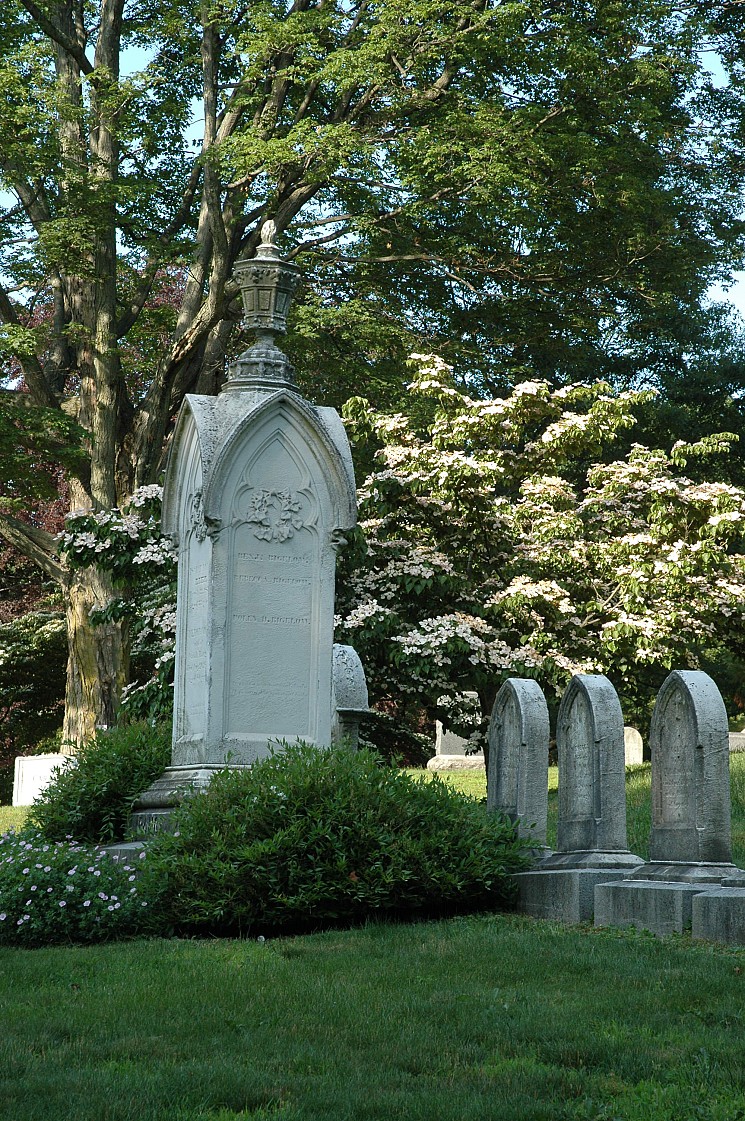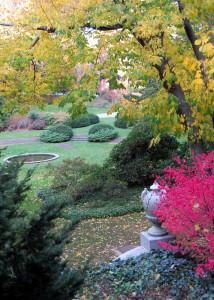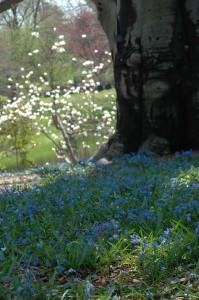An Introduction to our Plant Collections

Mount Auburn’s plant collections include over 16,000 plants  and 1,700 plant taxa, making it comparable to many other botanic gardens in the country. What might make Mount Auburn unique to the more “typical” botanic garden, however, is its extraordinarily long history and mission that does not specify how these plants are assembled or displayed. Most botanic gardens and arboreta are charged with finding and growing particular plants in a particular way, whereas at Mount Auburn the mission seeks to maintain “…a landscape of exceptional beauty and tranquility; providing comfort and inspiration to the bereaved and the public as a whole, protecting and improving [the] historic landscape, monuments, architecture, horticulture and natural resources.” Mount Auburn’s founders began building a collection of plants shortly after the Cemetery’s founding in 1831. This founding predates the establishment of all but one other botanic garden in the United States: Bartram’s Garden in Philadelphia, which was founded in 1728.
and 1,700 plant taxa, making it comparable to many other botanic gardens in the country. What might make Mount Auburn unique to the more “typical” botanic garden, however, is its extraordinarily long history and mission that does not specify how these plants are assembled or displayed. Most botanic gardens and arboreta are charged with finding and growing particular plants in a particular way, whereas at Mount Auburn the mission seeks to maintain “…a landscape of exceptional beauty and tranquility; providing comfort and inspiration to the bereaved and the public as a whole, protecting and improving [the] historic landscape, monuments, architecture, horticulture and natural resources.” Mount Auburn’s founders began building a collection of plants shortly after the Cemetery’s founding in 1831. This founding predates the establishment of all but one other botanic garden in the United States: Bartram’s Garden in Philadelphia, which was founded in 1728.
 Motivation for expanding and diversifying Mount Auburn’s plant collections has varied from generation to generation. A scientific interest in trying new and interesting plants from distant parts of the world characterized the early years after its founding. That same interest re-appeared in the 1930s under the leadership of Mount Auburn president Oakes Ames. In other periods, a bias towards landscape style/fashion and maintenance practices took precedence. During the Victorian period in the late 19th century, a rare coexistence of these two biases seems to have occurred as people loved plant novelties and also insisted on the practice of high-maintenance landscaping. Yet it seems fair to say that biodiversity in the collections would not be kept if they didn’t look good, no matter how interesting they might be. Safeguarding the quality of the overall landscape, which is another thing that separates Mount Auburn’s mission from those of most other botanic gardens, has been important since the beginning.
Motivation for expanding and diversifying Mount Auburn’s plant collections has varied from generation to generation. A scientific interest in trying new and interesting plants from distant parts of the world characterized the early years after its founding. That same interest re-appeared in the 1930s under the leadership of Mount Auburn president Oakes Ames. In other periods, a bias towards landscape style/fashion and maintenance practices took precedence. During the Victorian period in the late 19th century, a rare coexistence of these two biases seems to have occurred as people loved plant novelties and also insisted on the practice of high-maintenance landscaping. Yet it seems fair to say that biodiversity in the collections would not be kept if they didn’t look good, no matter how interesting they might be. Safeguarding the quality of the overall landscape, which is another thing that separates Mount Auburn’s mission from those of most other botanic gardens, has been important since the beginning.
 Today, several initiatives are important factors in maintaining Mount Auburn’s landscape and the care for its plant collections: the implementation of a maintenance approach that employs more ecologically sustainable practices, the introduction of new plantings for the improvement of wildlife habitat, and the creation of garden spaces associated with the development of new burial space.
Today, several initiatives are important factors in maintaining Mount Auburn’s landscape and the care for its plant collections: the implementation of a maintenance approach that employs more ecologically sustainable practices, the introduction of new plantings for the improvement of wildlife habitat, and the creation of garden spaces associated with the development of new burial space.
PLANT COLLECTIONS SUMMARY
Overall Collections
Total Plants/Massed Plants: 16,772
Total Known Taxa*: 1,754
Botanical Families Represented: 106
Generea Represented: 364
Trees
Total recorded plants: 4,771
Total number of taxa: 624
Shrubs and Dwarf Trees: 4,654
Total number of taxa: 495
Groundcovers (woody & herbaceous)**
Total number of plantings: 3,481
Total number of taxa: 627*
Taxa with the highest representation in the collections
TREES
Shade Trees
Acer saccharum (Sugar Maple, incl. cultivars) 317
Quercus rubra (Red Oak) 190
Acer platanoides (Norway Maple, incl. cultivars) 108
Quercus alba (White Oak) 76
Quercus velutina (Black Oak) 49
Conifers
Pinus strobus (Eastern White Pine) 217
Tsuga canadensis (Canadian Hemlock) 189
Pseudotsuga menziesii (Douglas Fir) 133
Chamaecyparis pisifera (Sawara Falsecypress & cultivars) 112
Picea abies (Norway Spruce) 83
Ornamental Trees
Cornus florida (Flowering Dogwood, incl. varieties & cultivars) 268
Malus – identified (Flowering Crabapple) 122
Magnolia – various (Magnolia) 87
Acer palmatum (Japanese Maple, incl. cultivars) 79
Cornus kousa (Kousa Dogwood, incl. cultivars) 78
SHRUBS and DWARF TREES
Taxus cuspidata & Taxus x media (Yews, incl. cultivars) 805
Kalmia latifolia (Mountain Laurel, incl. cultivars) 447
Ilex crenata ‘Convexa’ (Japanese Holly)
Pieris japonica (Japanese Andromeda, incl. cultivars) 143
Berberis thunbergii (Japanese Barberry, incl. cultivars) 124
GROUNDCOVERS (massed plantings)
Hedera helix (English Ivy, incl. cultivars) 862
Hosta – various (Hosta) 226
Vinca minor (Myrtle, incl. cultivars) 194
Euonymus fortunei (Wintercreeper Euonymus, incl. cvs.) 155
Pachysandra terminalis (Pachysandra, incl. cultivars) 113
*Taxa are considered to be unique valid plant names. They represent several levels of classification including: species, sub-species, variety, hybrid, and cultivar.
**For this purpose, ‘shrubs’ comprises both shrubs and dwarf trees. The category ‘groundcover’ comprises groundcovers, herbaceous perennails, and woody vines.
DISCRETE PLANT COLLECTIONS
Many discrete collections are included within Mount Auburn’s overall horticultural collection. The term “collections” at most botanic gardens can be used to describe the different ways of looking at groups of plants. It can mean collections of a botanical family/genus/species, or it can mean a geographical collection of plants from the same continent/country/state/county, or it can group plants from the same eco-habitat (e.g. bog/swamp/forest/meadow/alpine/tropical). At Mount Auburn, we find it useful to identify collections within each of these meanings. Our discrete plant collections include:
NAACP Oaks Collection
Aquatic and Wetlands-emergent Vegetation
Wildflower Meadow
Butterfly Garden
Dwarf Conifers
Crabapples
Flowering Cherries
Dogwood Cultivars
Victorian-period Plants
Woodland Plants
This overview of Mount Auburn’s plant collections was abridged from the Mount Auburn Cemetery Plant Collections Anaylsis prepared by Horticultural Curator Dennis Collins and Curatorial Associate Karla Erickson in April 2011.
Leave a Reply to Cindy Frueh Cancel reply